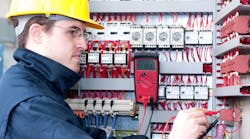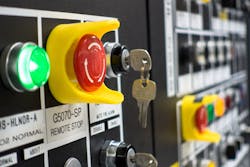Chapter 2 of NFPA 70E, Standard for Electrical Safety in the Workplace, provides the requirements for practical safety-related maintenance of electrical equipment and installations that fall under the Scope [90.2] of this standard [200.1]. The thrust of Chapter 2 is to identify what needs maintaining for the purposes of employee safety.
The first requirement is in Art. 205. It’s also an OSHA requirement. You’ll find an OSHA-compliant definition in Art. 100. The requirement is that the work be performed by a qualified person. The general electrical work definition is that this person has demonstrated skills and knowledge related to the construction and operation of the electrical equipment and has been trained to identify and avoid the hazards involved.
Chapter 2 adds another layer to this definition, requiring the person to be trained in and familiar with the specific maintenance procedures and tests required [205.1]. The specificity aspect is critical, as similar equipment may have sufficiently different maintenance procedures to create problems.
Specificity can be pretty granular. For example, on one model of circuit breaker, you lubricate with a specific stockroom number of grease but on another you use a different grease. If the greases are incompatible, the maintenance technician will create grit that prevents the breaker from opening under fault.
NFPA 70E doesn’t try to sort these details out, but instead requires the employer to choose from the various maintenance methods available and ensure the chosen methods conform with “manufacturer’s instructions or industry consensus standards” [205.3]. Cases arise where the manufacturer’s published recommendations don’t match the demands of an atypical application. Notice the wording is “manufacturer’s instructions,” which covers such situations; you just need to consult with the manufacturer for instructions that address your application.
Keep maintenance records
Chapter 2 requires documenting the maintenance, testing, and inspections of overcurrent protective devices (OCPDs). It doesn’t provide a documentation requirement for any other kind of equipment. At first glance, the exclusion of a long list of equipment from this requirement doesn’t make sense. Documenting equipment condition is an essential part of ensuring equipment reliability.
If we go back to the Scope of Chapter 2, we see the reasoning. If you want to “save money” by not tracking, trending, and analyzing maintenance data on other equipment so you can prevent failure and downtime, that’s your choice. You just can’t practice that kind of false economics with your OCPD maintenance.
Chapter 2 names 11 other assets you must maintain (even if, for some reason, you don’t document that maintenance):
- Working spaces and clearance around equipment [205.5]. Also covered in other standards.
- Bonding and “grounding” connections of equipment, raceway, cable tray, and enclosures [205.6] to maintain electrical integrity of the equipment grounding conductor (EGC), which is (per NEC Art. 100 definitions of bonding and grounding) a bonding conductor.
- Enclosures [205.7]. These need to guard against accidental contact with energized conductors and other electrical hazards. An example of maintenance is replacing damaged or missing knockout plugs.
- Locks, interlocks, and other safety equipment [205.8]. Specifically, they must be kept in proper working condition; that’s usually a higher standard than just performing the prescribed maintenance steps. You may have to test the operation to know if they work or not.
- Clear spaces [205.9]. This differs from working space around equipment. It’s the space you need to get to the working space plus the space to get out of there in a hurry if you need to. You can read a good treatment of this issue in NEC Art. 646 [Modular Data Centers]. In the typical production plant, the space usually is there structurally, but it might be restricted by “creative” use of “floor space recovery techniques” whereby boxes, crates, cabinets, fixtures, and other objects effectively constrict that space below the minimum needed for safety.
- Component identification and safety-related instructions (operating or maintenance) [205.10]. The key is they must be securely attached and legible. Tools and systems specifically for this purpose are available from your electrical distributor.
- Warning signs [205.11]. They must meet the same requirements as component identifiers, with the addition that they must be visible. In this context, visible has an obvious meaning beyond the basic meaning of the word.
- Circuit and voltage identification [205.12]. Things change, keep these up to date.
- Single and multiple conductors and cables [205.13]. Keep them free of damage, shorts, and ground that would present an electrical hazard to employees.
- Flexible cords and cables [205.14]. Replace any that are worn, frayed, or damaged. Ensure they have proper strain relief, proper polarity, grounding, and grounding continuity.
- Overhead line clearance [205.15]. Where under employee control, maintain the grade elevation to preserve (at least) the minimum designed clearances.
While Chapter 2 doesn’t explicitly require you to document the maintenance of the 11 aforementioned assets, documentation is a core element of effective and reliable maintenance. Nearly all production plants today use a computerized maintenance management system (CMMS). Have you created an asset ID for specific clear spaces and entered them into your CMMS? If you have chronic issues with those clear spaces, not having done so would be a contributing factor. Let the CMMS generate reports for failures there, the same as it does for production equipment.
Switchgear
Article 210 provides requirements that apply to six kinds of equipment:
- Substations.
- Switchgear assemblies.
- Switchboards.
- Panelboards.
- Motor control centers.
- Disconnect switches.
You must maintain:
- Equipment enclosures so they are free of material that presents an electrical hazard to employees [210.1].
- Area enclosures (e.g., fences) to guard against unauthorized access or accidental contact with energized parts [210.2].
- Current-carrying conductors (including terminations) and bracing to conduct the rated current without overheating and withstand the available fault current [210.3].
- Protective devices so they adequately withstand or interrupt available fault current [210.5].
Another maintenance requirement seems to be a subset of 210.3: Maintain insulation integrity to support the voltage impressed [210.4]. It’s worth calling this out separately, because assessing conductor insulation integrity is a specialty. It requires understanding how and when to perform various tests. No single test gives you enough information to prove a conductor is good, though one test can prove it’s bad. You must also understand how to interpret the results of each test in relation to previous tests and baseline test data.
This takes considerable expertise as well as considerable resources. The typical facility doesn’t have the expertise, nor does it have the staff required to conduct this testing during the peak labor demand of a maintenance shutdown. The solution is to work with an electrical testing firm; initiate the planning several months before the shutdown.
Miscellaneous maintenance
After Art. 210 comes a series of short Articles naming things that must be maintained (our list “leaps” at the end):
- Article 215. Premises wiring.
- Article 220. Controller equipment.
- Article 225. Fuses and breakers.
- Article 230. Rotating equipment.
- Article 240. Batteries and battery rooms.
The leap is across Art. 235, a longer Article that provides maintenance requirements for hazardous locations. Nearly half of it consists of Informational Notes below the Scope [235.1]. Then nine maintenance criteria are laid out in 235.2. None of these would surprise anyone familiar with the NEC (e.g., “Required markings are secure and legible”). They are enumerated, and it’s not a bad idea to use the list verbatim to make a checklist for maintenance purposes.
Portables
For portable electric tools and equipment, Art. 245 addresses the attachment plugs, receptacles, cover plates, and cord connectors. It provides five inspection criteria.
PPE
The final Article in Chapter 2 provides requirements for maintaining PPE [250]. It begins by enumerating 14 kinds of personal protective equipment (PPE). A very wide category, protective clothing, is No. 12 on the list. Eleven of the other 13 items are not worn by the worker, and include such things as hot sticks, insulated tools, and bypass jumpers.
Two kinds of inspection are required [250.2]:
- Visual. Inspect before initial use and “at intervals thereafter” as service conditions require. The interval can’t exceed one year, unless specified otherwise by the respective ASTM standard.
- Testing. Apply the recommended test to ascertain insulating capability before initial use and “at intervals thereafter” as service conditions require (max 3-yr interval).
Personal protective ground sets must be maintained per the requirements spelled out in 250.3(A) through (C). Test equipment and test leads used to verify the absence or presence of voltage must be maintained to assure functional integrity [250.4].
Getting there from here
Many organizations are already compliant with Chapter 2 requirements. But if yours isn’t, begin by adding the safety assets to your maintenance program.
Assign the labor hours to each maintenance task, just as you do for production assets. Generate a report that management can use for correct resource allocation. Don’t let the fact that you dangerously under-maintained at a lower cost be a factor in deciding whether to perform all of the proper maintenance now. Good luck lasts only so long.
Lamendola is an electrical consultant located in Merriam, Kan. He can be reached at [email protected].






